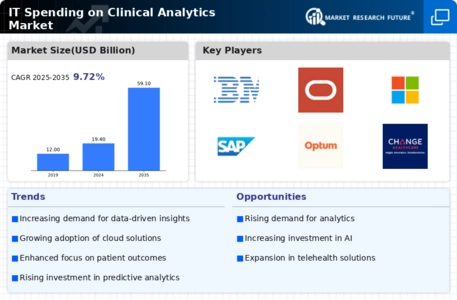It Spending On Clinical Analytics Market Summary
As per MRFR analysis, the IT Spending on Clinical Analytics Market was estimated at 19.42 USD Billion in 2024. The IT Spending on Clinical Analytics industry is projected to grow from 21.31 USD Billion in 2025 to 53.89 USD Billion by 2035, exhibiting a compound annual growth rate (CAGR) of 9.72 during the forecast period 2025 - 2035.
Key Market Trends & Highlights
The IT Spending on Clinical Analytics Market is experiencing robust growth driven by technological advancements and increasing demand for data-driven insights.
- The market is witnessing a rise in cloud-based solutions, particularly in North America, which remains the largest market.
- Integration of artificial intelligence is becoming prevalent, enhancing the capabilities of clinical analytics across various healthcare settings.
- Data security and compliance are gaining heightened focus, especially in the context of regulatory requirements in the Asia-Pacific region.
- The increased demand for data-driven decision making and advancements in technology are key drivers propelling market growth.
Market Size & Forecast
| 2024 Market Size | 19.42 (USD Billion) |
| 2035 Market Size | 53.89 (USD Billion) |
| CAGR (2025 - 2035) | 9.72% |
Major Players
IBM (US), Oracle (US), SAP (DE), Cerner Corporation (US), McKesson Corporation (US), Allscripts Healthcare Solutions (US), Philips Healthcare (NL), Epic Systems Corporation (US), Siemens Healthineers (DE)


















Leave a Comment